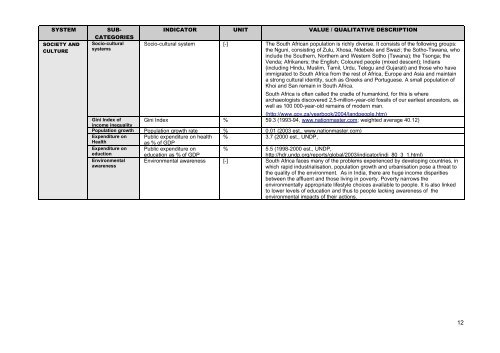E-WASTE ASSESSMENT IN SOUTH AFRICA - e-Waste. This guide
E-WASTE ASSESSMENT IN SOUTH AFRICA - e-Waste. This guide
E-WASTE ASSESSMENT IN SOUTH AFRICA - e-Waste. This guide
Create successful ePaper yourself
Turn your PDF publications into a flip-book with our unique Google optimized e-Paper software.
SYSTEMSOCIETY ANDCULTURESUB-CATEGORIESSocio-culturalsystems<strong>IN</strong>DICATOR UNIT VALUE / QUALITATIVE DESCRIPTIONSocio-cultural system [-] The South African population is richly diverse. It consists of the following groups:the Nguni, consisting of Zulu, Xhosa, Ndebele and Swazi; the Sotho-Tswana, whoinclude the Southern, Northern and Western Sotho (Tswana); the Tsonga; theVenda; Afrikaners; the English; Coloured people (mixed descent); Indians(including Hindu, Muslim, Tamil, Urdu, Telegu and Gujarati) and those who haveimmigrated to South Africa from the rest of Africa, Europe and Asia and maintaina strong cultural identity, such as Greeks and Portuguese. A small population ofKhoi and San remain in South Africa.South Africa is often called the cradle of humankind, for this is wherearchaeologists discovered 2,5-million-year-old fossils of our earliest ancestors, aswell as 100 000-year-old remains of modern man.(http://www.gov.za/yearbook/2004/landpeople.htm)Gini Index of Gini Index % 59.3 (1993-94, www.nationmaster.com; weighted average 40.12)income inequalityPopulation growth Population growth rate % 0.01 (2003 est., www.nationmaster.com)Expenditure on Public expenditure on health % 3.7 (2000 est., UNDP,Healthas % of GDPExpenditure oneductionPublic expenditure oneducation as % of GDP% 5.5 (1998-2000 est., UNDP,http://hdr.undp.org/reports/global/2003/indicator/indi_80_3_1.html)EnvironmentalawarenessEnvironmental awareness [-] South Africa faces many of the problems experienced by developing countries, inwhich rapid industrialisation, population growth and urbanisation pose a threat tothe quality of the environment. As in India, there are huge income disparitiesbetween the affluent and those living in poverty. Poverty narrows theenvironmentally appropriate lifestyle choices available to people. It is also linkedto lower levels of education and thus to people lacking awareness of theenvironmental impacts of their actions.12
















